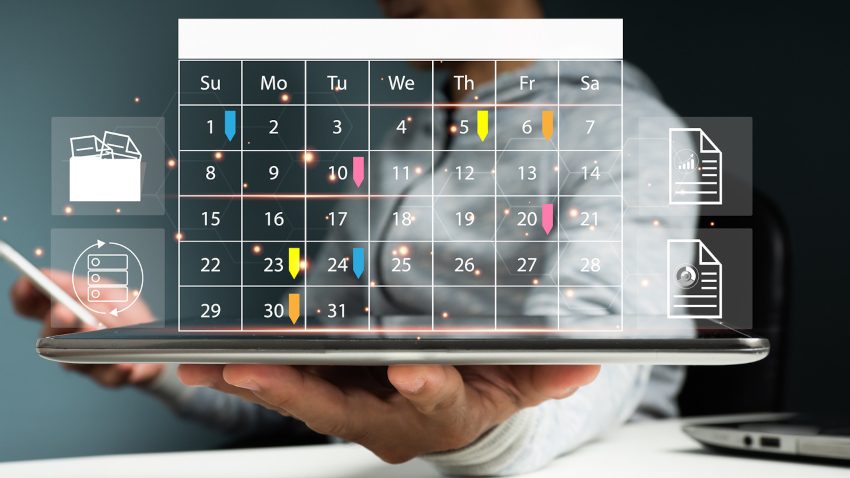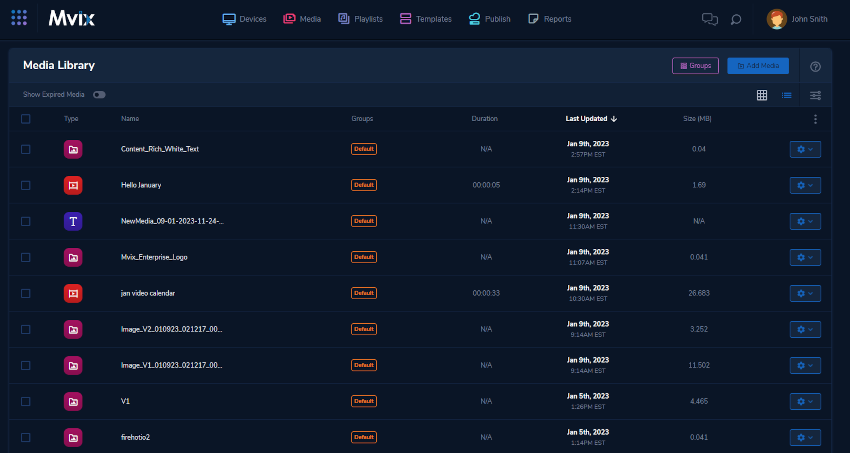Digital Signage Content Management and Organization for 2024
The global digital signage software market, driven by players such as Yodeck, OptiSigns, TelemetryTV, ScreenCloud, and, industry leader Mvix, is expected to grow by a 15.84% CAGR from 2022-2029. With this influx, more businesses will invest in digital signage solutions and will need to manage this IoT tool to maximize their return on investment.
Digital signage solutions consist of two primary components: digital signage hardware and software. The hardware consists of digital screens, mounts, and a digital signage media player.

The content management system (CMS) is the digital signage software. Arguably, this is the most important part of a digital signage solution as your content is what captivated your audience and keeps them engaged with your message. If you do not have engaging content and your audience passes by your screens, your digital signage solutions aren’t fulfilling their purpose.
Digital signage CMS provides you with the features to create, schedule, and publish your images, texts, live broadcasts, social media posts, RSS feeds, webpages, wayfinding maps, videos, and digital signage content in other formats. Succinctly put, the CMS makes it easy to manage your entire digital signage system from a central point.
This digital signage software solution makes operations such as new content creation and updating playlists for your video walls, menu boards, touchscreen kiosks, and other digital signs with new content run smoothly. To top it off, one person can easily manage multiple digital displays when you have the right CMS.
Managing your content for the new year can be overwhelming and tedious to organize and manage while attending to your other task. Here are some tips to manage and organize your digital signage content so that you’re maintaining consistent communication with your audience and maximizing deployment time with your solution.
The Role of a Digital Signage CMS
Your network’s CMS has two primary functions as outlined:
1. Content Management
It is right there in the name; indeed, content management is the primary function of a CMS. You can take charge of
- Type of Content: Choose what shows on your signage screens, be it text, images, video, or real-time streams. The best digital signage software is highly versatile and supports various content formats. Therefore, you can integrate apps, use the drag-and-drop interface and use available templates to create content.
- The Sequence of Display: Choose which content goes first and what comes next when you create a playlist for your digital signage network. Excellent digital signage management allows you to easily alternate between the various times of content, ensuring flawless transitions.
- Display Timing: Set up your digital signage platform to show specific content at specific times. For instance, think of a happy hour menu you would like to only show at your restaurant’s happy hour. Actually, keep in mind that 0.7-0.9 seconds is the average dwell time for digital signs.
2. Device Management and Diagnostics
A good CMS will help you to view and manage your digital signage. You can easily rename a device, reset its passwords and permissions, edit its preset on and off times, and even reboot the device.

Monitor and supervise the performance of your devices on the CMS dashboard. If one or more displays go offline, you will receive notifications on your CMS. This may be due to disconnection from power or the internet or a more severe problem. For simple issues such as a lost internet connection, refreshing the CMS may help. In contrast, you’d need technical support for more complex and severe problems.
Choosing the Right CMS for Digital Signage Management
There are a few crucial pointers to keep in mind when comparing CMS options. Consider the following, among other pointers.
- Media Player and Operating System Compatibility and Support: Does the CMS only support one or a few digital signage players, or do you have more options? With a 76% market share, Windows is the most dominant OS. However, consider if the CMS supports other options, including Android, Linux, and Chrome OS.
- User-Friendly Rating: How easy is navigating the CMS and executing the tasks?
- Flexibility and Integrations: How easy is integrating content into your digital signs through apps, widgets, plugins, API, RSS feeds, and more? You’ll have a larger pool of data sources for digital signage management.
- Cloud-Based or Desktop Download: With a web-based CMS, you can access the system from anywhere, even on an iPad or other mobile devices, improving your capacity for on-the-go digital signage management. On the other hand, you’d need to be at your station to access your desktop download CMS.
- Pricing: Consider the price against the features, service, and support package.
Mvix CMS for Optimized Digital Signage Management
In the highly competitive digital signage software vertical, Mvix has built and maintained its reputation for providing top-tier end-to-end solutions to customers. In fact, Mvix’s CMS is an easy pick for any enterprise looking to stay on top of managing its digital signage network, and the software’s popularity is no surprise.
Packed with some great features and backed with excellent technical support, here are some stand-out features of the CMS that will help you achieve hassle-free digital signage management.
1. Media Library for Management

How the media library works in Mvix’s CMS is quite straightforward. The library features ready-to-use media, and you can easily view and edit this media for use on your digital signs. For example, if you’re looking to refresh your content, you can easily add new files to the library and a particular playlist and delete what is outdated.
With all your media in one place and some excellent templates and layouts streamlines the creation of content for your digital signage solution. That you can manage and perform some tasks on multiple media items in the library will save you time. Of course, you can also manage each media item individually.
2. Pre-Scheduling: Creating a Content Schedule
Content scheduling makes digital signage management more efficient and saves you time. Preset a timing and duration for your content on multiple playlists. This removes the pressure of creating playlists as you go, and you can focus on other tasks. For instance, you can schedule content for a week, a month, or even a couple of months in advance. Explore how to annually schedule your digital signage.
Above all, even as you schedule content, remember to set up a priority channel for high-priority and urgent messaging. The content published on this channel will disrupt your schedule and take over your screens for a scheduled time or until you manually go back to normal settings.
3. The NOC Module
Mvix’s unique NOC module provides a central platform for monitoring and troubleshooting your digital signage network devices. The interface’s visualizations show the health and status of individual devices.
So, based on various performance metrics, you will receive an alert or alarm whenever there are issues with your network, such as network connection and hardware issues. This enterprise-grade module helps to maximize device uptime, ensuring you get maximum return on your investment.
4. Multiple Device Management
Whether you have several devices in your digital signage network or hundreds, manage all under the device library. Additionally, it makes no difference whether all your devices are in the same place or dispersed across various geographical locations. You can see each device’s name, status, IP address, and other characteristics.
A great tip that works great, especially for larger networks, is grouping your devices. This way, you can assign schedules to each group instead of assigning a schedule for each device individually. For instance, grouping the devices in the lobby across multiple locations is an excellent idea, as you’d be displaying the same content for all. Think of a welcome message and some information about your company.
Let the Pros Help

Digital signage management can be complex, but if done right, you can maximize the return on your investment. Work with reputable and reliable software providers to get the best software solution, as well as tips for content and device management. Similarly, you can opt for managed services program where the provider takes care of digital signage management, and you can focus on your core business.


